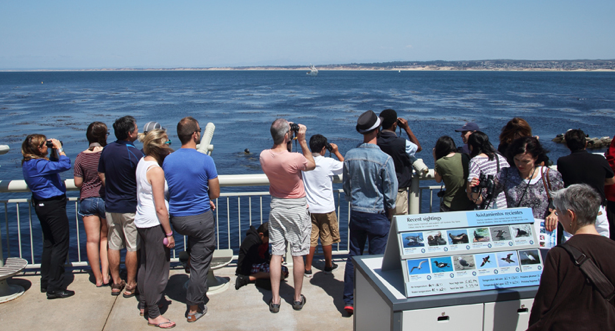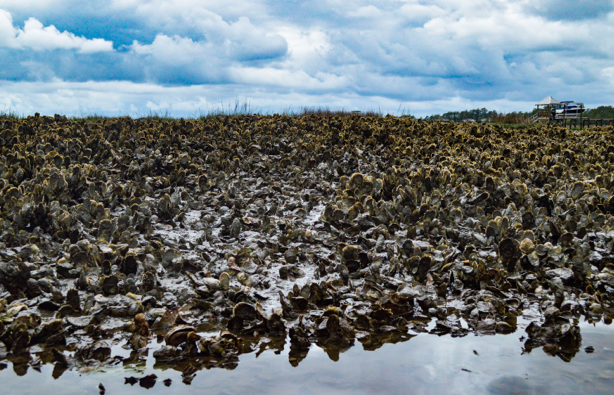We Need a Sea Change in How We Communicate about Ocean Change. Metaphors Can Help.

This is the fourth post in a series about framing ocean and climate change.
We depend on our oceans and must protect them, yet they are often overlooked in public conversations about “climate change.” As a result, most people don’t understand how ocean change affects the climate (and vice versa)—or how these changes affect our planetary and public health. What’s more, they don’t understand the major causes of ocean change and are unaware of major threats to ocean health like acidification and temperature rise.
This poses a challenge for advocates and experts who communicate about ocean change. The way that ocean and climate change is currently understood—the way it is framed in our collective conscience—limits how people reason about associated problems and possible solutions. If people don’t understand ocean and climate as systems, they won’t be able to see the scale of the problem or the need for systems-level solutions and policies.
So, how can we get oceans into the public story about climate change? How do we cue up systems-thinking? And how can we communicate about our oceans so that people understand and appreciate not only their important role in the climate system but also the systems-level solutions we need to protect them?
We need a sea change in the way we talk about ocean change.
Framing Ocean Change
The FrameWorks Institute, a communications think tank in Washington, DC, teamed up with the National Network for Ocean and Climate Change Interpretation (NNOCCI) to answer these and other questions. With funding from the National Science Foundation, FrameWorks researched more effective ways to communicate about—or frame—climate and ocean change.
To conduct the research, FrameWorks interviewed experts and members of the public about these issues and compared the differences in understanding between them. FrameWorks also tested how certain values (deeply held ideals in American culture) affected whether people care about climate and ocean change. These findings—and the communications recommendations that emerged—were summarized in earlier Climate Interpreter posts.
FrameWorks followed this work with studies investigating how metaphors can help people understand the complex concepts of climate and ocean change. The goal of the research was to find “explanatory” metaphors that can help the public understand that:
- The ocean controls the flow of moisture and heat (i.e., the climate) across the globe.
- Burning fossil fuels affects the ocean’s ability to regulate the climate system.
- Climate change is causing ocean acidification, which is affecting marine life.
- There are solutions for addressing and mitigating climate and ocean change.
Two Effective Metaphors
FrameWorks found that two metaphors helped people understand these points. The first compares the ocean’s role in the climate system to the heart’s role in the body. Put another way, the oceans regulate the climate in the same way that the heart regulates blood flow in the body. Just as the heart circulates the right amount of blood to the body’s organs, the oceans control the distribution of heat and humidity in the atmosphere.
This metaphor helps people understand that the ocean is a vital part of the climate system—and not separate and fundamentally different from the rest of it. It gives people a “mechanistic” understanding that explains how climate change is connected to extremes in temperature and precipitation. And it helps people understand that damage to the ocean (by burning fossil fuels like coal, oil and natural gas) endangers the overall climate. Perhaps most importantly, it communicates the importance of protection and conservation. In the same way that people can take steps to prevent damage to the heart (through regular exercise and a healthy diet), we can also take steps to prevent damage to the ocean (by reducing fossil fuels).

The second metaphor explains an issue most members of the public have never heard about: increasingly acidic marine environments that are making it harder for shellfish to grow and maintain their shells—changing chemistry that is changing the ecology of the ocean. Because people don’t know about or understand this phenomenon of ocean acidification, they don’t know what steps to take to combat it. The Osteoporosis of the Seametaphor helps people overcome this barrier.
Scientists often compare this process to the calcifying effect of osteoporosis on the bones of the body. Both processes have the effect of creating thinner, more brittle supportive structures. FrameWorks tested the metaphor and found it helped people learn about and understand the effect of acidification on the ocean. Learn more about these metaphors—and other effective frame elements—in these reframe cards developed by the FrameWorks Institute.
The metaphor was found to be especially productive when incorporated into an “explanatory chain”—a set of sentences that connect the causes of a problem with its consequences. The explanation that was tested—and proven effective—follows:
When we burn fossil fuels like coal and gas, we release carbon dioxide into the air. The ocean absorbs a lot of this carbon dioxide, which is changing the ocean’s chemistry—a process called ocean acidification. One result of this change in chemistry is that carbonate—something shellfish use to build their shells—becomes scarce. This means there will be fewer shellfish in the food chain for other creatures to eat, which then affects the whole ecosystem.
This explanation helps the public make sense of ocean acidification, reason why and how it is a problem and why intervention is necessary. It also helps people understand what is at stake in changing ocean and climate systems—systems that support and sustain all of us. The urgency and salience of the problem is tied to a better understanding of how solutions work to address it.
For more information about how and why these metaphors advance and enhance environmental communications, read How to Talk about Climate Change and the Ocean, a MessageMemo produced by the FrameWorks Institute. Click here for more resources about effective environmental communications frames.
More Blog Posts
 Fresh ideas for talking about ocean acidificationFresh ideas for talking about ocean acidification by Richelle Tanner, July 30 2020 Our NNOCCI associate, Dr. Scott Doney, along with his colleagues, has recently published an updated review of the effects of ocean acidification on marine ecosystems (see here for a previous review). Read on for a summary of their main findings, and to understand [READ MORE]
Fresh ideas for talking about ocean acidificationFresh ideas for talking about ocean acidification by Richelle Tanner, July 30 2020 Our NNOCCI associate, Dr. Scott Doney, along with his colleagues, has recently published an updated review of the effects of ocean acidification on marine ecosystems (see here for a previous review). Read on for a summary of their main findings, and to understand [READ MORE] Sea Slugs Make Climate Evolutionary ChoicesSea Slugs Make Climate Evolutionary Choices by Richelle Tanner, July 01 2019 Nudibranchs are a type of sea slug known for their beautiful colors and curious incorporation of other animals and plants into their own bodies (e.g. using plant chloroplasts to photosynthesize, incorporating toxins into their cells, and swallowing anemones’ stinging [READ MORE]
Sea Slugs Make Climate Evolutionary ChoicesSea Slugs Make Climate Evolutionary Choices by Richelle Tanner, July 01 2019 Nudibranchs are a type of sea slug known for their beautiful colors and curious incorporation of other animals and plants into their own bodies (e.g. using plant chloroplasts to photosynthesize, incorporating toxins into their cells, and swallowing anemones’ stinging [READ MORE] Climate Emotions: Helpless Or Hopeful?Climate Emotions: Helpless Or Hopeful? by Heidi Zamzow, April 17 2019 With the recent IPCC warning that we may have perhaps a dozen years before we encounter severe and irreversible impacts of climate change, it comes as little surprise that a recent survey* in climate communications research indicates 7 in 10 people in the U.S. are concerned [READ MORE]
Climate Emotions: Helpless Or Hopeful?Climate Emotions: Helpless Or Hopeful? by Heidi Zamzow, April 17 2019 With the recent IPCC warning that we may have perhaps a dozen years before we encounter severe and irreversible impacts of climate change, it comes as little surprise that a recent survey* in climate communications research indicates 7 in 10 people in the U.S. are concerned [READ MORE] The Science of ExtremesThe Science of Extremes by Richelle Tanner, July 13 2021 Extreme is a word that can send a climate communicator directly into the swamp: the word extreme is inherently a bit alarming, and vague enough to warrant a multi-sentence qualification when you use it. Even scientists disagree on what this word means and in which context it is appropriate. [READ MORE]
The Science of ExtremesThe Science of Extremes by Richelle Tanner, July 13 2021 Extreme is a word that can send a climate communicator directly into the swamp: the word extreme is inherently a bit alarming, and vague enough to warrant a multi-sentence qualification when you use it. Even scientists disagree on what this word means and in which context it is appropriate. [READ MORE] Cut through Confusion with Appeals to Protection and ResponsibilityCut through Confusion with Appeals to Protection and Responsibility September 07 2016 This is the third in a series about framing ocean and climate change. Advocates and experts are familiar with common—but often untrue—tropes about our environment. How can we cut through them and communicate in a way that deepens understanding about the complex [READ MORE]
Cut through Confusion with Appeals to Protection and ResponsibilityCut through Confusion with Appeals to Protection and Responsibility September 07 2016 This is the third in a series about framing ocean and climate change. Advocates and experts are familiar with common—but often untrue—tropes about our environment. How can we cut through them and communicate in a way that deepens understanding about the complex [READ MORE]